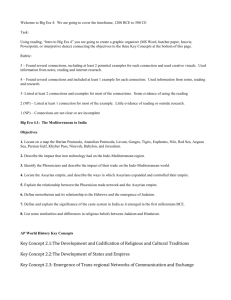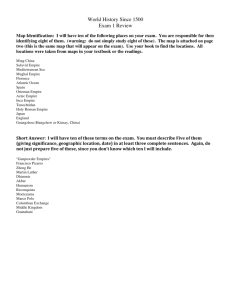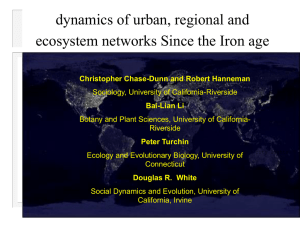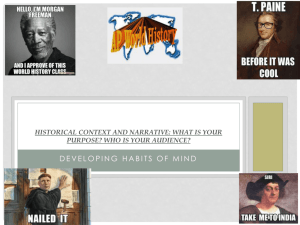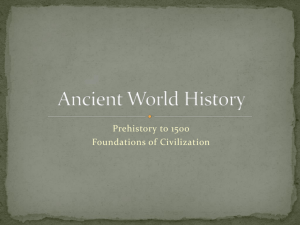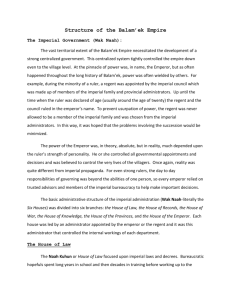Answers - Classical Empires Snapshot Chart
advertisement
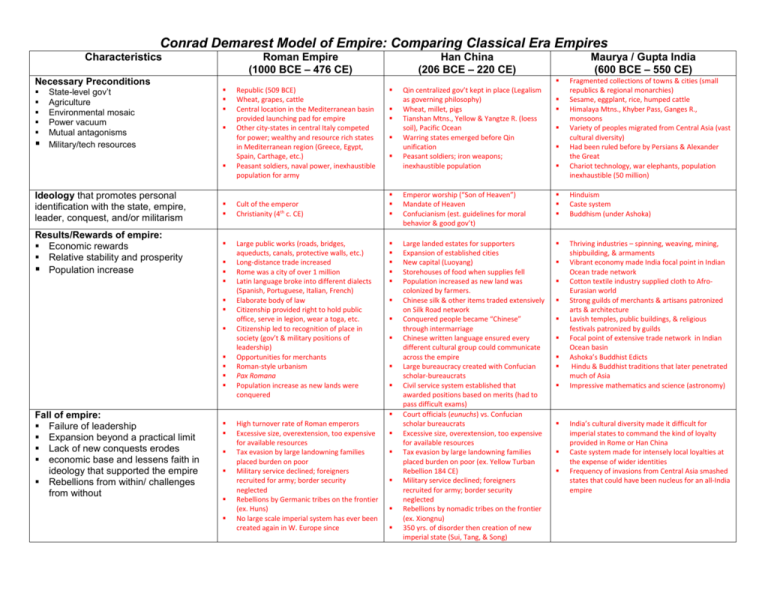
Conrad Demarest Model of Empire: Comparing Classical Era Empires Characteristics Necessary Preconditions State-level gov’t Agriculture Environmental mosaic Power vacuum Mutual antagonisms Military/tech resources Roman Empire (1000 BCE – 476 CE) Results/Rewards of empire: Economic rewards Relative stability and prosperity Population increase Republic (509 BCE) Wheat, grapes, cattle Central location in the Mediterranean basin provided launching pad for empire Other city-states in central Italy competed for power; wealthy and resource rich states in Mediterranean region (Greece, Egypt, Spain, Carthage, etc.) Peasant soldiers, naval power, inexhaustible population for army Cult of the emperor Christianity (4th c. CE) Large public works (roads, bridges, aqueducts, canals, protective walls, etc.) Long-distance trade increased Rome was a city of over 1 million Latin language broke into different dialects (Spanish, Portuguese, Italian, French) Elaborate body of law Citizenship provided right to hold public office, serve in legion, wear a toga, etc. Citizenship led to recognition of place in society (gov’t & military positions of leadership) Opportunities for merchants Roman-style urbanism Pax Romana Population increase as new lands were conquered Fall of empire: Failure of leadership Expansion beyond a practical limit Lack of new conquests erodes economic base and lessens faith in ideology that supported the empire Rebellions from within/ challenges from without Maurya / Gupta India (600 BCE – 550 CE) Ideology that promotes personal identification with the state, empire, leader, conquest, and/or militarism Han China (206 BCE – 220 CE) High turnover rate of Roman emperors Excessive size, overextension, too expensive for available resources Tax evasion by large landowning families placed burden on poor Military service declined; foreigners recruited for army; border security neglected Rebellions by Germanic tribes on the frontier (ex. Huns) No large scale imperial system has ever been created again in W. Europe since Fragmented collections of towns & cities (small republics & regional monarchies) Sesame, eggplant, rice, humped cattle Himalaya Mtns., Khyber Pass, Ganges R., monsoons Variety of peoples migrated from Central Asia (vast cultural diversity) Had been ruled before by Persians & Alexander the Great Chariot technology, war elephants, population inexhaustible (50 million) Emperor worship (“Son of Heaven”) Mandate of Heaven Confucianism (est. guidelines for moral behavior & good gov’t) Hinduism Caste system Buddhism (under Ashoka) Large landed estates for supporters Expansion of established cities New capital (Luoyang) Storehouses of food when supplies fell Population increased as new land was colonized by farmers. Chinese silk & other items traded extensively on Silk Road network Conquered people became “Chinese” through intermarriage Chinese written language ensured every different cultural group could communicate across the empire Large bureaucracy created with Confucian scholar-bureaucrats Civil service system established that awarded positions based on merits (had to pass difficult exams) Court officials (eunuchs) vs. Confucian scholar bureaucrats Excessive size, overextension, too expensive for available resources Tax evasion by large landowning families placed burden on poor (ex. Yellow Turban Rebellion 184 CE) Military service declined; foreigners recruited for army; border security neglected Rebellions by nomadic tribes on the frontier (ex. Xiongnu) 350 yrs. of disorder then creation of new imperial state (Sui, Tang, & Song) Thriving industries – spinning, weaving, mining, shipbuilding, & armaments Vibrant economy made India focal point in Indian Ocean trade network Cotton textile industry supplied cloth to AfroEurasian world Strong guilds of merchants & artisans patronized arts & architecture Lavish temples, public buildings, & religious festivals patronized by guilds Focal point of extensive trade network in Indian Ocean basin Ashoka’s Buddhist Edicts Hindu & Buddhist traditions that later penetrated much of Asia Impressive mathematics and science (astronomy) Qin centralized gov’t kept in place (Legalism as governing philosophy) Wheat, millet, pigs Tianshan Mtns., Yellow & Yangtze R. (loess soil), Pacific Ocean Warring states emerged before Qin unification Peasant soldiers; iron weapons; inexhaustible population India’s cultural diversity made it difficult for imperial states to command the kind of loyalty provided in Rome or Han China Caste system made for intensely local loyalties at the expense of wider identities Frequency of invasions from Central Asia smashed states that could have been nucleus for an all-India empire

